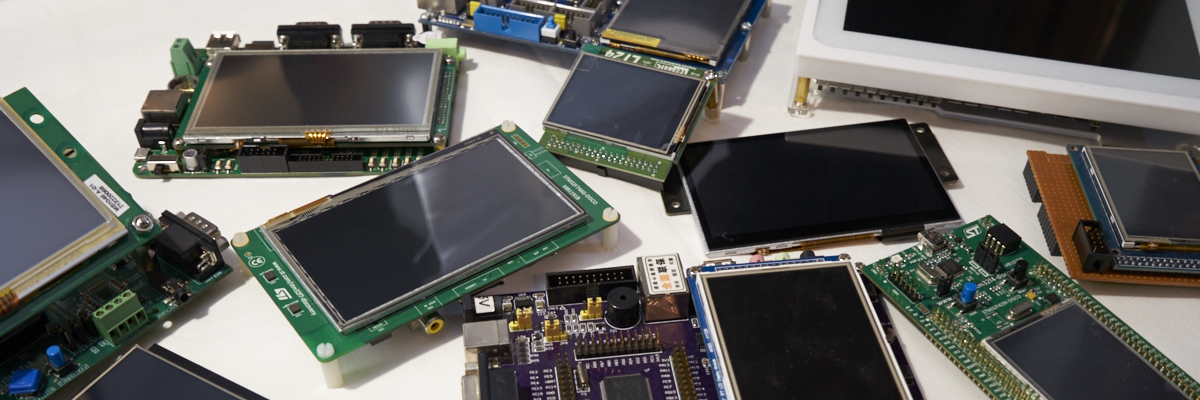-
Posts
2,659 -
Joined
-
Last visited
-
Days Won
2
Content Type
Forums
Store
Downloads
Blogs
Everything posted by Joel Bodenmann
-
Did you check for differences in the configuration file gfxconf.h? Make sure that when converting the image yourself you use the file2c flags -dcs as described in the wiki.
-

Support for STM32F469i-Discovery
Joel Bodenmann replied to inakto's topic in Development and Feedback
The µGFX library v2.8 includes support for the STM32F469i-Discovery board that works out of the box. Please try that. -

how to get virtual keyboard event?
Joel Bodenmann replied to dragonzhang's topic in Development and Feedback
Glad to hear that everything is working -

how to get virtual keyboard event?
Joel Bodenmann replied to dragonzhang's topic in Development and Feedback
Hello and welcome to the µGFX community! Did you have a look at the virtual keyboard example that you can find in /demos/modules/gwin/keyboard? I am pretty sure that you're missing this line: // We also want to listen to keyboard events from the virtual keyboard geventAttachSource(&gl, gwinKeyboardGetEventSource(ghKeyboard), GLISTEN_KEYTRANSITIONS|GLISTEN_KEYUP); -
Yes, you can run µGFX on that A20 without any problems. µGFX runs on Linux out of the box without any problems. You can either use the SDL or X11 drivers or you can use the driver that directly accesses the linux framebuffer. All of those exist and are working out of the box. The same applies to touchscreen, mouse & keyboard input. There is no existing example for that specific setup but you can have a look at the raspberry-pi example if that helps you: https://wiki.ugfx.io/index.php/Raspberry_Pi
-
Well.... why don't you just display an image then?
-
Hi, You can find pre-compiled binaries of the font converter in the /tools directory of the µGFX library. That allows you to run the font converter locally without any restrictions.
-
That's the µGFX-Studio: We are happy to help with whatever we can. The µGFX developers themselves actually maintain this forum in their spare time. Alternatively, you can purchase a support plan form our website. You usually start off by having a working project for your platform. Once you have everything running, you'll just add the µGFX library to that as you would with any other library. There is a generic documentation that explains how to add the µGFX library to an existing project on the wiki. Additionally, there are many different IDE specific guides out there that you can have a look at. As far as I know, CCS is Eclipse based so the generic Eclipse guide or the IDE specific guides for IDEs that are Eclipse based (eg. ChibiStudio) will help. Along these lines: @cpu20 is the IDE integration specialist of this community We provide µGFX drivers that allow rendering to a QWidget and to retrieve user inputs from that QWidget to the µGFX library. It's basically a driver that makes a QWidget become a virtual display (with touchscreen).
-
Did you check the return value of the gdispImageCache() function call? An image decoder can refuse to cache the image. An image also won't be cached if there's not enough memory left.
-
glad to hear that you got it working
-
You can mix C and C++ without any problems. You just have to make sure that you use the C++ compiler to compile C++ sources and the C compiler to compile C sources. That seems to be the most common mistake. Other than that, you can of course not include C++ code (eg. #include <iostream> or #include <functional>) in code that gets compiled by the C compiler.
-
You don't need a pixmap in this case. You can simply cache the image using gdispImageCache(). A cached image is stored as a decompressed bitmap just like it would in the pixmap with the simple benefit that in some cases, some really basic RLE will be applied that decreases the image size without having a real impact on the rendering performance. To answer your question anyway: You render to a pixmap like you would to any other display. A pixmap is nothing but a virtual display. You use all the normal GDISP rendering calls. Therefore, you can render an image to a pixmap using the regular gdispGImageDraw() function. The wiki demonstrates rendering to a pixmap: https://wiki.ugfx.io/index.php/Pixmaps
-
Great! Thank you for sharing that with the community!
-
You have to enable unicode support in your configuration file. Of course, also make sure that your source file(s) are unicode encoded as well when you hard-code your strings. Furthermore, make sure that the Chinese glyphs are not being filtered-out by the default filter range of the online converter.
-
You can either use the flashing property provided by GWIN (gwinSetFlashing()) or you can implement a custom widget that uses a GTIMER internally to render if you need more control. Do not simply call gwinHide() and gwinShow() periodically. While that has visually the same effect you'll not get what you want as your button will not receive any events while not being visible (meaning you can't click it).
-
Can you please show us pictures of both pages (eg. the previous page as well)?
-
gdispFillString() does only fill the bounding rectangle of the string. The bounding rectangle depends on the string you are rendering - although you use the same font you'll have different rectangles based on the string. gdispFillStringBox() allows you to specify the size of the box. Hence that is the correct one to use in this case.
-
I'm pretty sure that you're using gdispDrawString() instead of gdispFillString() or gdispFillStringBox(). The gdispDrawString() only renders (changes) the pixel of the actual new string. Everything else remains the same. gdispFillString() and gdispFillStringBox() will clear the pixels not occupied by the string with the corresponding background color. Use those.
-
I'm sorry, this is not a code::blocks support forum.
-
Hello and welcome to the µGFX community! You can use the µGFX library with any IDE. There's a generic guide here: https://wiki.ugfx.io/index.php/Getting_Started#Integrate_uGFX and there are more IDE specific guides listed on the front page: https://wiki.ugfx.io/index.php/Main_Page
-
Can you please provide a ZIP containing your entire ChibiOS project so we can have a go on it ourselves? We haven't had any problems at all with using µGFX with ChibiOS and neither did anybody else - this has to be something very small in the build setup
-
Hello @Stewels and welcome to the µGFX community! I took a look at your makefile and this is wrong: # GFX files. include $(GFXLIB)/tools/gmake_scripts/library_ugfx.mk include $(GFXLIB)/tools/gmake_scripts/os_chibios_git.mk Please follow this guide to add µGFX to your existing ChibiOS project: https://wiki.ugfx.io/index.php/Using_ChibiOS/RT
-

[Suggestion] Debug Console for Desktop Environment
Joel Bodenmann replied to Unbendable's topic in Development and Feedback
Thank you for your feedback, we appreciate it a lot! I'm not really sure what you'd expect. Usually you need to debug your application, not the library you're using. So simply using fprintf() as suggested by @inmarket should get the job done. -
@inmarket I already have his project with the corresponding changes in uGFX.
-

Problem of using GInput on bare metal/RAW32
Joel Bodenmann replied to AlexMiron31's topic in Support
Glad to hear that you got it working! I was somehow under the impression that you don't get anything on the display - this definitely makes sense. I assume the errors you're getting are due to the fact that there's not enough RAM to fit the uGFX heap during linking time.

